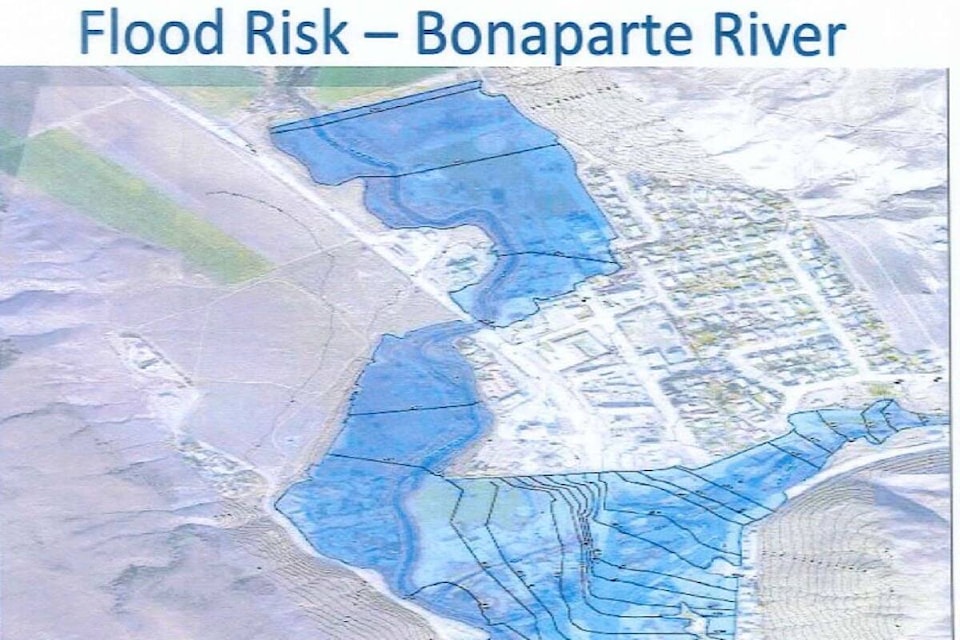A flood mitigation plan prepared for the Village of Cache Creek has identified a number of risks and challenges faced by the community in dealing with flooding, and recommended mitigation steps totalling more than $14 million to address these risks and protect the community, its infrastructure, and its residents and businesses.
In June 2020 the village received grant funding of $147,000 to move ahead with the flood mitigation plan, which was prepared by TRUE Consulting. At its meeting on Dec. 6, council heard a presentation from professional engineers Dave Underwood and Ariana Paulson of TRUE, who gave an overview of the plan and took questions.
READ MORE: Cache Creek receives grant funding for flood mitigation plan
The plan is intended to give council and staff a thorough understanding of the current and future flood risks facing the community, so that they can mitigate community flood risk, as well as budget and seek funding assistance for the implementation of the measures outlined in the plan. These include nonstructural measures (planning, floodplain mapping, land use management, and policy implementation) and structural ones, which involve physical changes or activities.
Among the non-structural measures recommended in the plan are an investigation (@$290,000) of things such as the sanitary sewer system, infrastructure crossings of watercourses, and bridge condition assessment; an update of the Official Community Plan (@$16,000); creation of a floodplain bylaw (@$5,000), which would create a floodplain setback for new development; and the preparation of a flood response plan (@$50,000).
Structural mitigation measures recommended in the plan include improvements along the Cache Creek corridor, such as “daylighting” the culverts at Quartz Road, behind the fire hall, and on Highway 97 at the Dairy Queen and moving infrastructure onto new bridge crossings (@$3.8 million); improvements to the water system (@$4.7 million); and sanitary sewer system improvements (@$6 million).
Cache Creek Chief Administrative Officer Damian Couture says it’s tough to nail down one thing as being the most critical item on the list.
“In the opinion of the experts all these things need to be addressed, but some are definitely more serious than others. If I had to put my finger on one thing that would have a substantial short term impact it’s planning for an inundation of our water treatment system.”
He notes that one thing not in the plan — because the village has already addressed it — is raising the bed of the road that goes through the park to the water treatment plant. “We knew we had to raise the roadway to be above the 200-year high water line. In 2020 we had staff willing to wade through the flooded park to get to the plant, but there was no vehicle access, as water was over road.”
The village has also done a lot of work on the wells which provide the community’s water. “We currently use wells 6 and 7. Well 9, which is a twin of well 7, is drilled, and when we finalize its incorporation we’ll decommission well 6, which is considerably smaller. The work also includes different upgrades for critical infrastructure flood prevention, so if we have similar flooding to 2020 our water system will be safe.”
The plan examines Cache Creek and the Bonaparte River, but does not address Lopez Creek at the east end of town, which was a factor in the May 2015 flooding of the village. Couture says that the plan did not address rainfall events, such as the one in 2015, adding that a lot of the damage that happened then was down the line.
“It was an issue with Cache Creek and the Bonaparte, so if we mitigate those we’re doing 95 per cent of the work. It’s not that we don’t worry about that happening again, but if we’re looking at money to spend we need to look at where to get the most bang out of our buck.”
He notes that it is the three culverts that cause many of the problems. The Ministry of Transportation is doing temporary repairs at the Highway 97 culvert beside Dairy Queen, and Couture says there is a discussion about them doing a full replacement. “The culvert there is not the size it needs to be, and with all the flooding it’s in pretty significant disrepair. The temporary repairs are for that.”
Couture says that work on the culverts needs to start from the bottom-most one and work its way up to Quartz Road, where a variety of options are being looked at. “Quartz Road is a significant part of the village’s infrastructure, and the water displaced there significantly impacts downtown.”
He also feels that new rules about where people can build in the community will be added to the community plan. “A large part of this project was showing very specifically, property by property, where the safe level is. People could be away from a watercourse but below the 200-year floodplain mapping. If we use the new numbers we’ve received we would have it as part of the development permit that the foundation has to be above a certain level.”
Couture says that the village will have to proceed based on what they can afford, but notes that the plan allows them to be ready if funding opportunities come along: an important factor, given the recent disastrous flooding in the province and the number of communities that will also be looking for funding.
“We have a whole set of infrastructure-based projects that are grant-ready, so if a grant comes available and we can qualify for it we can go for it. It puts us at the front of the queue because we’ve done a lot of the groundwork. We’ve experienced this, and we know what we need. We’re ready to go if we can find an opportunity, and that gives us a leg up.”
editorial@accjournal.ca
Like us on Facebook and follow us on Twitter
